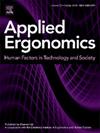Integrating an intuitive tactical navigation solution to enable situational awareness for people with visual disabilities
IF 3.4
2区 工程技术
Q2 ENGINEERING, INDUSTRIAL
引用次数: 0
Abstract
This research designed a wearable vibrotactile display for providing intuitive orientation and communication cues to aid in navigation for the visually disabled. The device’s signals were designed to communicate the three levels of situation awareness (SA; perceive, comprehend, and project) intuitively, as if one was being guided by a partner’s hand. We evaluated the effectiveness of this device in a human subject experiment with fully blind participants. Participants were tested in an open 15 ft x 15 ft space with no objects for reference. Performance with the vibrotactile display was compared against participants’ normal methods of navigation based on performance measures (navigation, accuracy, and time). Subjective measures of mental workload, situation awareness, and usability were collected; as were surveys designed to understand how participants’ categorized tactor signals into SA levels. Results showed that the tactile design enhanced accuracy, but increased navigation time. This design was comparable to participants’ standard methods for mental workload, SA, and usability. The paper discusses the significance of these results for navigation aids for the visually disabled. It also explores the implications for navigation support in other visually challenging environments.

集成一种直观的战术导航解决方案,为视觉障碍者提供态势感知能力
本研究设计了一种可穿戴的振动触觉显示器,为视障人士提供直观的方向和交流提示,以帮助他们导航。该设备的信号被设计用于传达三个级别的态势感知(SA;直觉地感知、理解和规划),就好像一个人被一个伙伴的手所引导。我们在一个全盲的人体实验中评估了这个装置的有效性。参与者在一个15英尺× 15英尺的开放空间中进行测试,没有任何可供参考的物体。根据性能指标(导航、精度和时间),将振动触觉显示器的表现与参与者的正常导航方法进行比较。收集心理负荷、情境意识和可用性的主观测量;以及旨在了解参与者如何将因素信号分类为SA水平的调查。结果表明,触觉设计提高了精度,但增加了导航时间。该设计与参与者在心理负荷、SA和可用性方面的标准方法相当。本文讨论了这些结果对视障人士助航设备的意义。它还探讨了在其他具有视觉挑战性的环境中导航支持的含义。
本文章由计算机程序翻译,如有差异,请以英文原文为准。
求助全文
约1分钟内获得全文
求助全文
来源期刊

Applied Ergonomics
工程技术-工程:工业
CiteScore
7.50
自引率
9.40%
发文量
248
审稿时长
53 days
期刊介绍:
Applied Ergonomics is aimed at ergonomists and all those interested in applying ergonomics/human factors in the design, planning and management of technical and social systems at work or leisure. Readership is truly international with subscribers in over 50 countries. Professionals for whom Applied Ergonomics is of interest include: ergonomists, designers, industrial engineers, health and safety specialists, systems engineers, design engineers, organizational psychologists, occupational health specialists and human-computer interaction specialists.
 求助内容:
求助内容: 应助结果提醒方式:
应助结果提醒方式:


